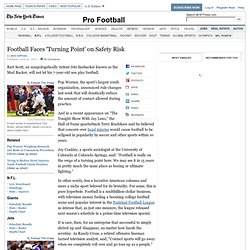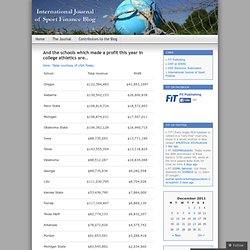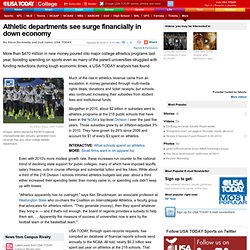

With Fears About Safety, Football Faces Uncertain Evolution. Pop Warner, the sport’s largest youth organization, announced rule changes last week that will drastically reduce the amount of contact allowed during practice.

And in a recent appearance on “The Tonight Show With Jay Leno,” the Hall of Fame quarterback Terry Bradshaw said he believed that concern over would cause football to be eclipsed in popularity by soccer and other sports within 10 years. Jay Coakley, a sports sociologist at the University of Colorado at Colorado Springs, said: “Football is really on the verge of a turning point here. We may see it in 15 years in pretty much the same place as boxing or ultimate fighting.” In other words, less a lucrative American colossus and more a niche sport beloved for its brutality. For some, this is pure hyperbole. It is rare, then, for an enterprise that successful to simply shrivel up and disappear, no matter how harsh the scrutiny. Football is an inherently physical game with little chance of ever fully eradicating the risk of injury. And the schools which made a profit this year in college athletics are… « International Journal of Sport Finance.
Here: Table courtesy of USA Today: That’s right 22 of 218 reporting schools did not lose money on athletics last year.

From the chart it is pretty clear that some schools were pretty big winners, with Oregon and Alabama really raking in the money for the 2009-2010 season. What is very nice about the USA Today site, is that one can even go look at the breakdowns school-by-school for both revenues and expenses. Curiously, many of the schools who are still making big profits are also taking extra money from their universities in the form of student fees. Really, the students are helping to finance extra revenue for some of these programs. The question does exist about the other 196 schools on the list who did not make a profit and how they spent their money. In all, this shows that while money talks in college athletics, there isn’t necessarily a lot of athletic departments making money, and it would seem some poor decisions are keeping some schools from being profitable.
Like this: Self-Sustaining Athletic Departments: More Than What Meets the Eye « Yesterday the list of self-sustaining athletic departments came out.

The good news is the number grew to eight more schools than last year. The bad news is the number is 22. That’s just shy of 10% of all public Division I institutions. Here’s a look at the 22 schools who turned a profit in the athletic department without having to rely on student fees or other forms of support from the university (including government funds): The chart is courtesy of USA Today. You know I like to give you more than what most media spoon-feeds you, so here are some thoughts and questions not covered in the USA Today article: Why are some of these schools still taking in student fees when they’re turning a profit? What are your initial thoughts on seeing the chart above?
Athletic departments see surge financially in down economy. By Steve Berkowitz and Jodi Upton, USA TODAY Updated 6/16/2011 3:10 AM | More than $470 million in new money poured into major college athletics programs last year, boosting spending on sports even as many of the parent universities struggled with funding reductions during tough economic times, a USA TODAY analysis has found.

By Eileen Blass, USA TODAY By Eileen Blass, USA TODAY Much of the rise in athletics revenue came from an escalation in money generated through multi-media rights deals, donations and ticket receipts, but schools also continued increasing their subsidies from student fees and institutional funds. Altogether in 2010, about $2 billion in subsidies went to athletics programs at the 218 public schools that have been in the NCAA's top-level Division I over the past five years. USA TODAY, through open-records requests, has compiled an database of financial reports schools send annually to the NCAA. For more information about reprints & permissions, visit our FAQ's.